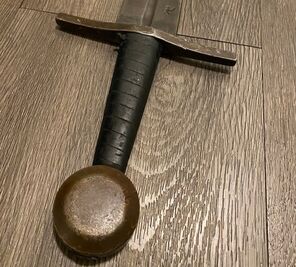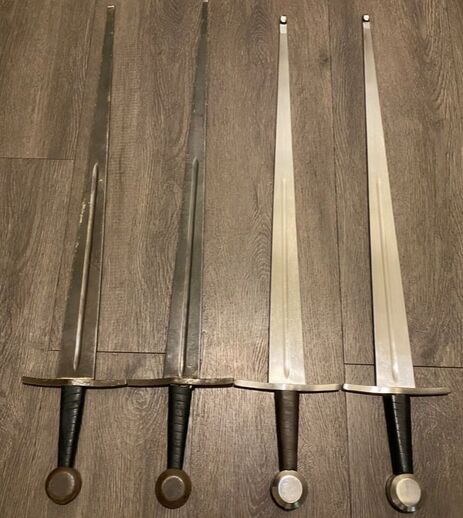|
Back in early 2018, I purchased a training sword crafted by Viktor Berbekucz (shortened to VB). I had no other swords to compare it to but at the time it was the sword I used to train with and it was great. I even took it to my first tournament and did decently well with it. In late 2018, I left my first fencing club and joined Vier Blossen Historical Fencing where I started a I.33 study group. Because I liked my sword so much I decided to buy myself a second type XIV by VB to loan to study partners. Now, in 2021, I find myself placing an order for two new Type XIV swords by VB to loan to students. After using swords by a number of manufacturers such as Regenyei, Albion, Black Fencer, and Kingston Arms, I still find myself going back from time to time to use a Type XIV by VB. So what makes these swords so special? Today we are going to discuss my thoughts on the Type XIV Arming Sword by Viktor Berbekucz and why I recommend them to everyone. Please note: I have linked the primary website for the sword to help assist in purchasing regardless of region. However, I purchased mine from Purpleheart Armoury. Durability One of the best features about the VB Type XIV sword is their durability. These swords are built for abuse and even after 3 years of hard sparring with them, my first sword still holds up and can be used safely for sparring. Everything from the blade to the pommel and even the leather grip on the handle are built to last. I still have the original wrapping on the handle that the sword came with back in 2018.  One area where the swords do show their use is in regards to the crossguard. After some time, the crossguards have come loose and rattle now. Originally I was able to hammer the crossguard back to being secure but I am unable to do so now on the older swords. That being said, I have yet to find an arming sword that this issue does not happen to after some time. My Regenyei Full Contact I.33 sword also suffers from a loose crossguard. This seems to be an inevitability with arming swords and should not be held against the Type XIV sword by VB. Cost Viktor Berbekucz swords continue to be one of the most affordable swords on the market (at least in the United States). With the price and the durability, these swords make a fantastic beginner sword purchase. Aesthetic There is something to be said about simplicity. The Type XIV sword by VB is not the flashiest training sword on the market but it definitely has the look of a sword. This sword’s simplicity feels in place with many common swords of the time and feels right at home with a priest and their student in a training setting in the early 14th century. Variability If there was any “critique” I would give to the Type XIV sword by VB it would be the variability in feel. This is partially due to the handcraftsmanship and also due to the span of time when comparing Viktor Berbekucz’s swords. Even with the variability discussed below, the quality of Viktor Berbekucz’s swords is not in question. These swords have withstood the test of time and have proven their worth. Furthermore, the newer swords feel better in the hand and also are more standardized than the swords purchased back in 2018. To further illustrate the variability, let’s take a look at the Type XIV sword by VB in my collection. Overall Length: 34.5 in Blade Length: 28.0 in Grip Length: 4.4 in Weight: 1264 grams Blade Width at Crossguard: 2.29 in Blade Width at Tip: .55 in POB Passed Crossguard (Approx.): 3 in Crossguard Length: 6.2 in The sword that started it all. This sword is best described as a “chopper”. The cuts feel slow but with the weight behind it, this sword can really back a punch with hewing cuts. Because of the weight, the sword serves well with binding actions, allowing for a fencer to easily control the bind against an opponent in most circumstances. The darker finish on this sword is the result of cold bluing I did to add some rust resistance. The bluing was done on the sword in early 2021 after years of cleaning the rust off of the blade (Texas humidity is not kind on swords). The weight feels further from the hands than with the next sword we are going to discuss. Overall Length: 35.3 in Blade Length: 28.8 in Grip Length: 4.5 in Weight: 1269 grams Blade Width at Crossguard: 2.19 in Blade Width at Tip: 0.41 in POB Passed Crossguard (Approx.): 2.8 in Crossguard Length: 6.5 in This next sword is the second sword I bought in 2018 and appears to be the oddball of the group. This sword is far narrower at the tip than the other swords. The weight of the sword feels closer to the hand as well. Overall, this sword feels nimble and even with the weight of it, this sword flows well in the cut to perform slicing actions with. Again, this sword has been blued to help with rust resistance. Overall Length: 34.0 in and 34.0 in Blade Length: 27.3 in and 27.5 in Grip Length: 4.3 in and 4.2 in Weight: 1126 grams and 1155 grams Blade Width at Crossguard: 2.23 in and 2.28 in Blade Width at Tip: 0.53 in and .52 in POB Passed Crossguard (Approx.): 2.8 in and 3.0 in Crossguard Length: 6.3 in and 6.3 in By the measurements, these swords appear more standardized than their 2018 clones. Another point of interest is the overall weight. Both of these swords are over 100 grams lighter than the 2018 swords and the improvement can be felt when performing cut drills with these swords. The overall durability appears to still be one of the best qualities of these swords though time will tell if they last longer than their stout 2018 counterparts. Who I Recommend It To The durability of these swords combined with their cost make these swords an easy recommendation for new fencers. However, do be warned, the durability is also one of the biggest drawbacks. These swords can hit hard and do not flex as much as more narrow bladed training swords. Because of this, new fencers must be careful and show good control when sparring with these to avoid injuring their sparring partners. For more advanced students, I recommend this sword for a different reason. While I prefer the feel and quickness of other swords, I still find myself sparring with these swords from time to time to practice good technique. The shortness of these blades combined with the heft of them makes it difficult to capitalize on distance with speedy attacks. These blades almost force fencers to control a bind and then close on their opponent before delivering an attack. This feature becomes critical for drilling good technique and to build strength during sparring. While these swords are great training tools, they can struggle a bit in tournaments. Their shortness and heft are their downfall against other swords on the market. While I would like to say that all tournaments are won with fantastic technique, the truth is that better equipment can provide an advantage in a fight. Will these swords win you any tournaments outright? Probably not. Will these swords help train good technique and handle themselves just fine in any fight? Absolutely. Closing Thoughts It is hard for me not to look at Viktor Berbekucz’s Type XIV sword without a feeling of nostalgia. It was my first steel training sword and was used in my first tournament. The first I.33 classes I taught featured two Type XIV swords by VB. The Type XIV Sword by VB is still one of my go-to swords as loaner equipment for students even after all these years.
I have never regretted purchasing these swords and they still help me when training I.33. The affordability combined with their durability and feel make these excellent training swords for students of all levels of experience.
0 Comments
Leave a Reply. |
Proudly powered by Weebly








